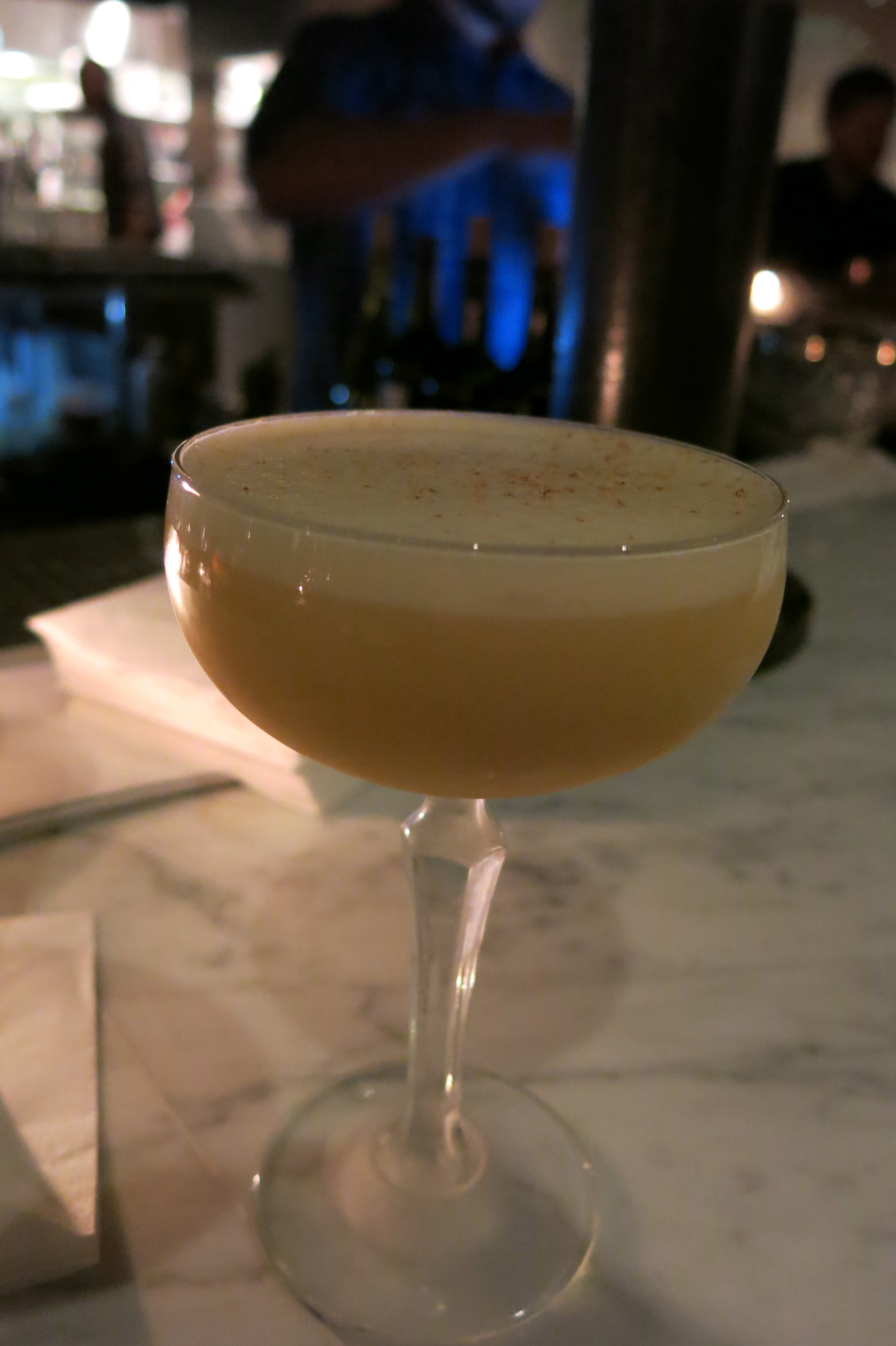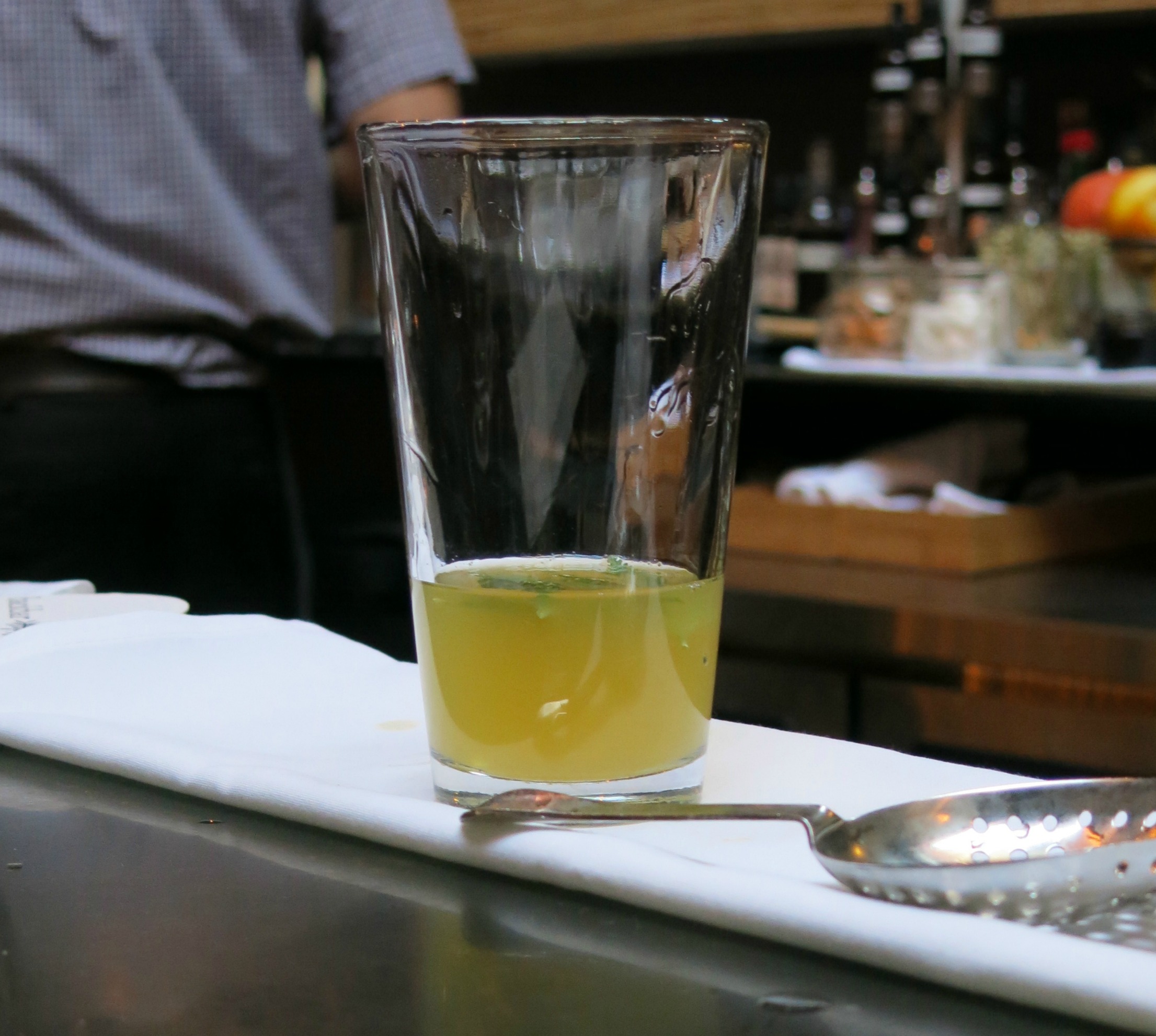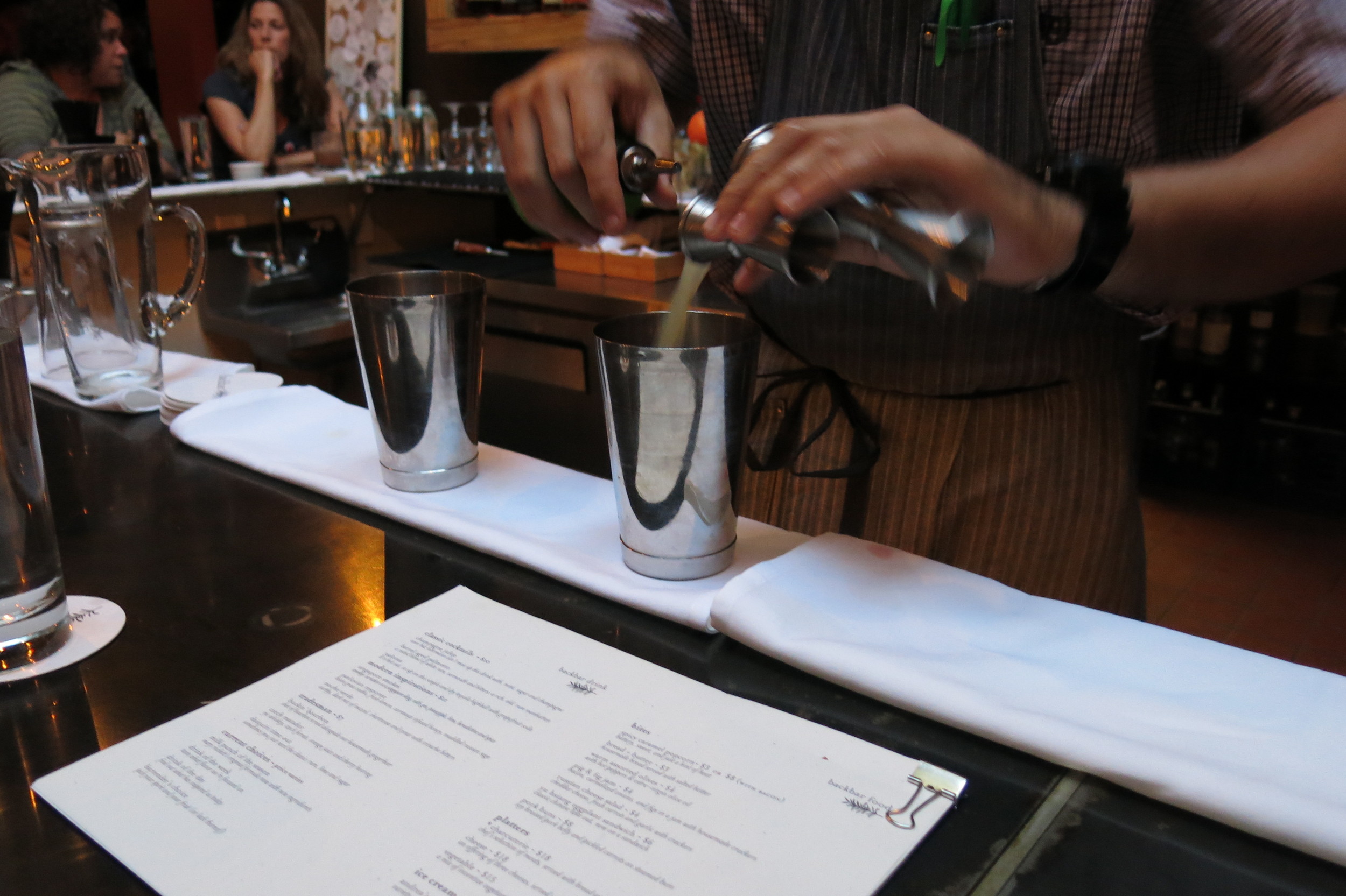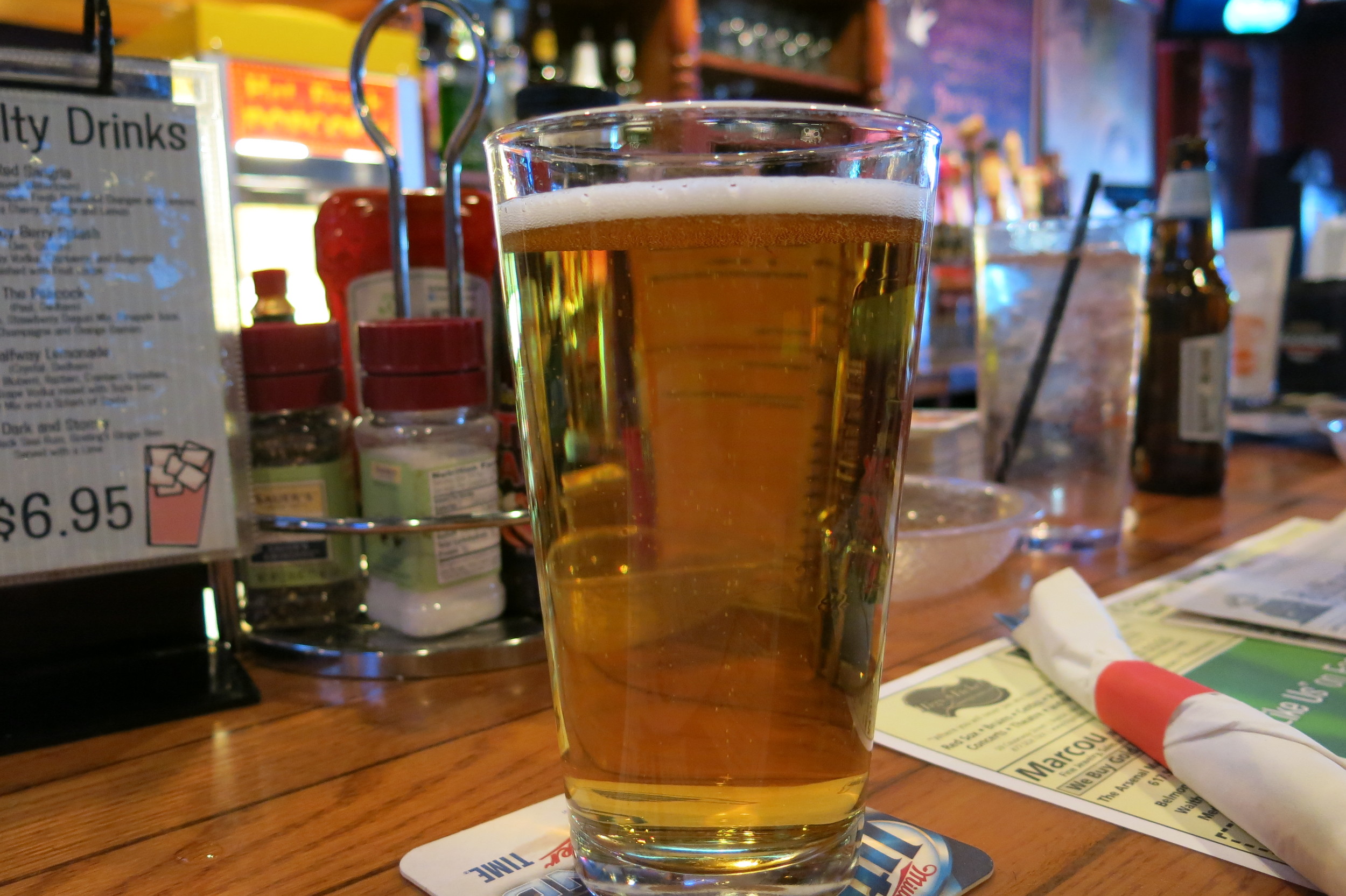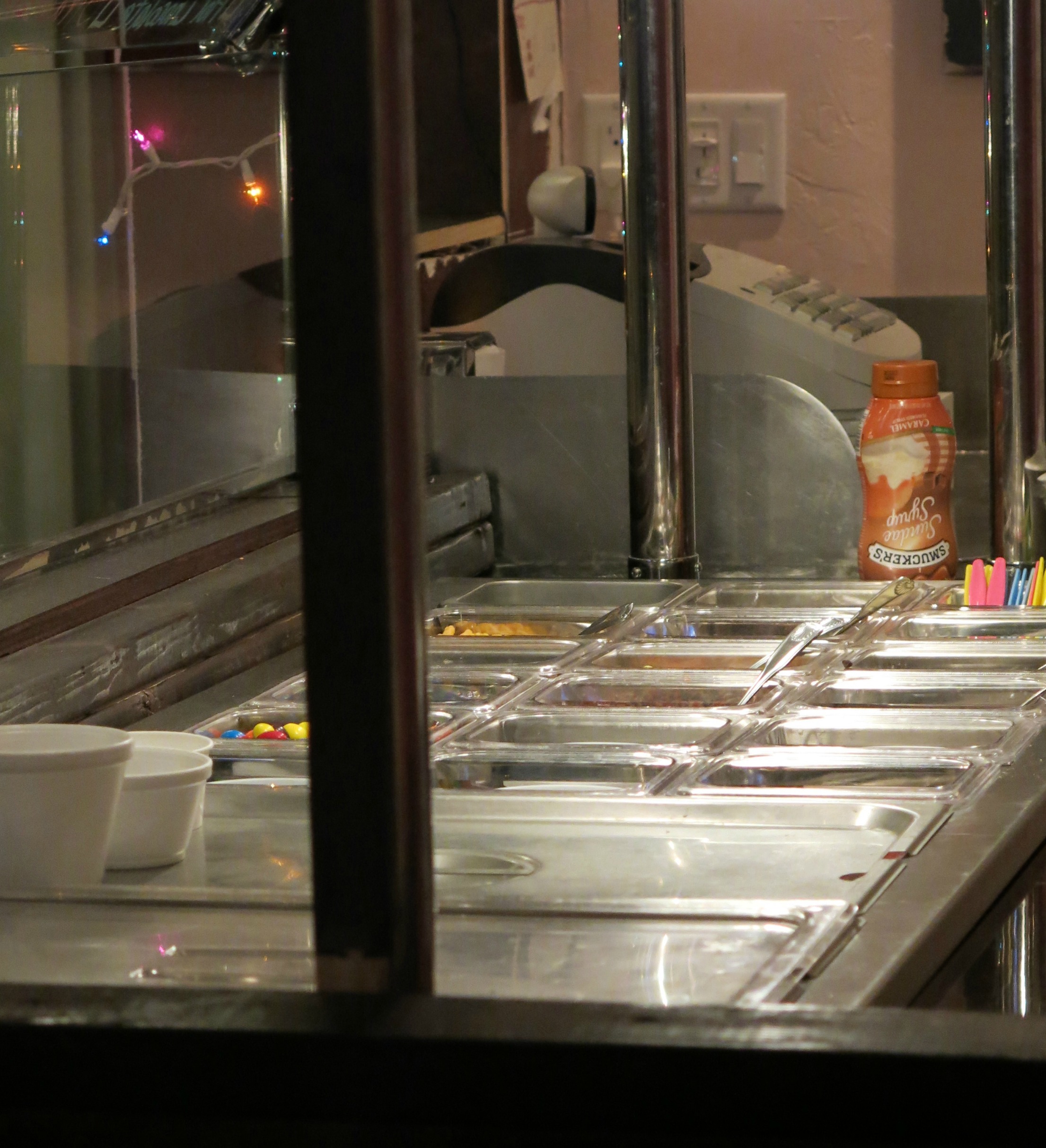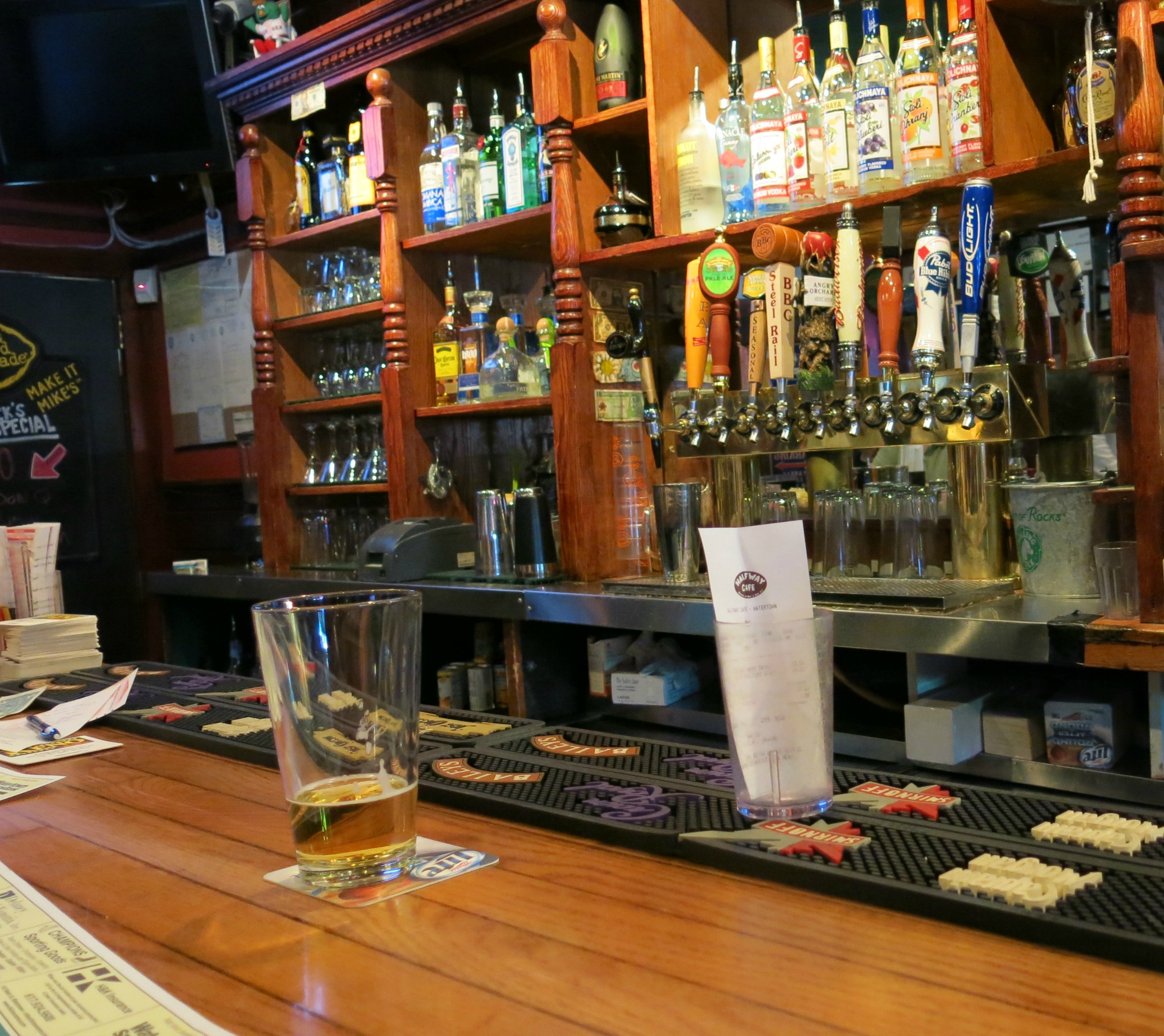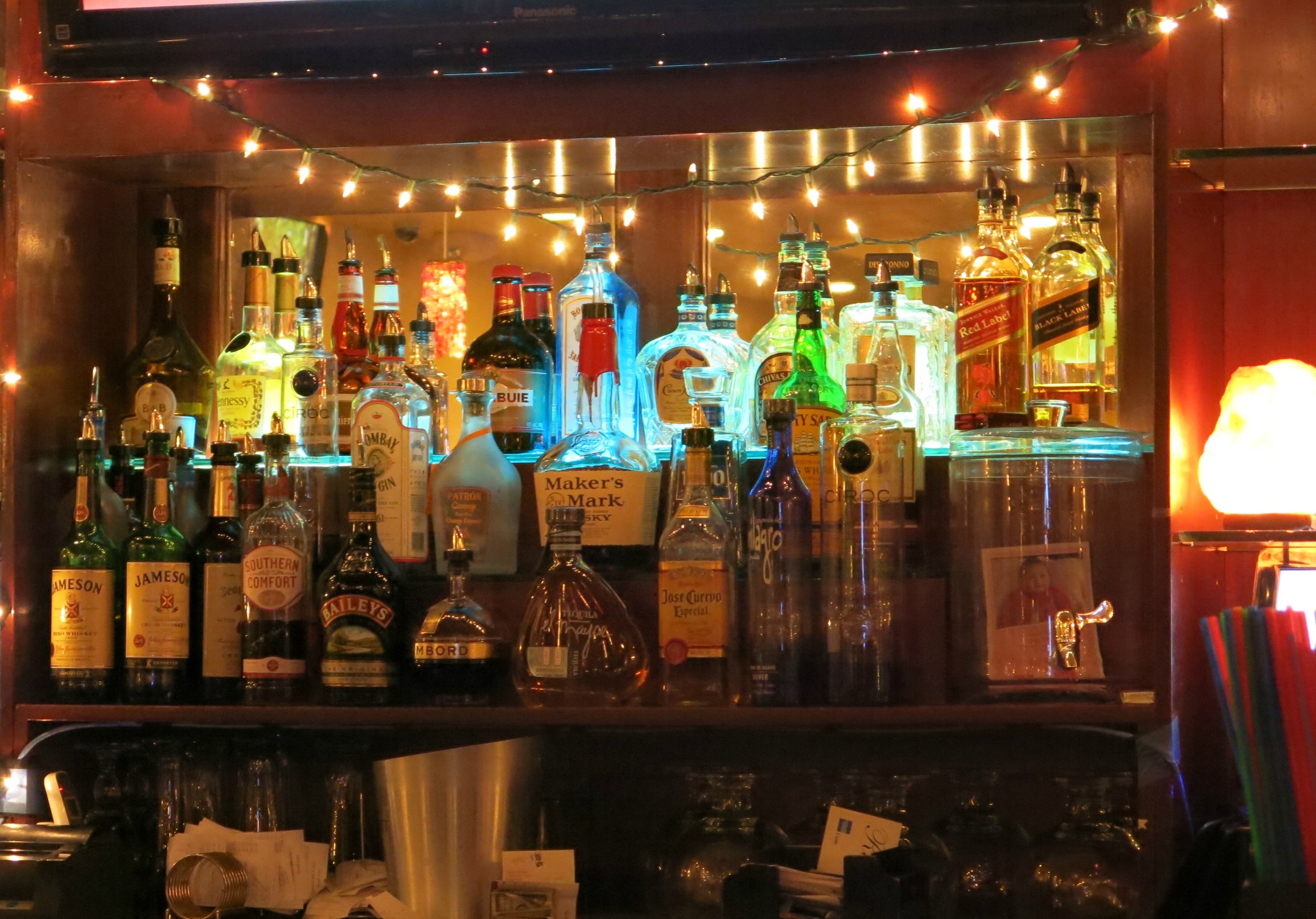Sumiao Hunan Kitchen
Lion's Tail
Product Review – Almond Orgeat Syrup by Liber & Co.
Empire Restaurant & Lounge
Shanghai Social Club
[Note: Shanghai Social Club has closed its doors, at least for the time being. I understand they'll reopen next year, with the same management but a "new concept."] Taking the Green Line to Allston from downtown Boston during afternoon rush hour is an exercise that would test the patience of a saint. The jerky motion and countless stops and starts can make a ride on the B branch feel like an ill-advised sailing trip on rocky seas. And that’s to say nothing of the uncomfortably close quarters – nearly 220,000 commuters squeeze into the trolleys every day, making the Green Line the busiest mode of public transportation in Boston. It can get worse, too – if the Red Sox are in town, the game-day crowd will increase your troubles tenfold.
Disembarking at the intersection of Harvard and Commonwealth would seem like a relief, but even that is not without its frustrations. Exiting the T into the gritty, densely populated neighborhood of Allston means navigating sidewalks crammed with pedestrians and streets gridlocked with cars, buses, and cabs. A perpetually busy neighborhood known for its large student population and concentration of bars and restaurants, Allston is not without its charms. But if you’re seeking a quiet refuge, it’s probably not at the top of your list.
And that’s the first thing that makes Shanghai Social Club so very un-Allston-like. Even before you peruse the impressive drink list, the first thing you notice is the absence of chaos.
“We’re the hidden gem of Allston,” general manager Farish Jenkins proudly declares. “You step out of all that and into a different realm.”
A different realm indeed. While modeling itself after “the social clubs and bars of the Bund area of Shanghai,” the calm, dimly lit setting of Shanghai Social Club fuses disparate elements from multiple eras of Asian history and culture, all filtered through an American lens that is at once kitschy and sincere. The walls are plastered with images of Chinese newspapers and vintage communist propaganda posters.
Birdcages and statuettes appear to be straight out of a Chinese street market. Candles and hanging red lanterns cast a soft glow on the Buddha statues of varying sizes that reside throughout the restaurant.
The space is surprisingly large, but smartly compartmentalized into four dining rooms, each of which feels cozy and distinct.
In the main room, a long, marble-topped bar is surrounded by about 15 chairs, while a few long tables round out the bar area.
And in the center of it all, a comfortable lounge evokes the shadowy atmosphere of an Old Shanghai opium den, with leather sofas and soft throw pillows. No one’s chasing the dragon here (presumably), but it’s perfect for conversation over potent drinks.
And there are plenty of those. Shanghai Social Club’s cocktail menu pays homage to old-school tiki styles while offering a few inventive house cocktails that stand up to the classics. And whereas so many Chinese restaurants offer a colorful array of cloyingly sweet Polynesian libations, Shanghai aims for substance and authenticity. “That’s the 1940s Trader Vic’s recipe,” Farish says of the Mai Tai.
Made with Flor de Cana Grand Reserve rum, Rhum Barbancourt, Cointreau, orgeat syrup, and lime juice, this traditional interpretation is refreshingly dry and not loaded with sugary fillers.
It’s a philosophy that informs the entire cocktail list. “All our juices are freshly made,” Farish tells me. “The only juice I have behind the bar that isn’t freshly squeezed is cranberry. We have a quality product in all our drinks.”
Like the Mai Tai, the Zombie stays true to its roots. Made with Appleton Estate Reserve rum, Brugal Extra Dry rum, orange curacao, lemon juice, grenadine, and a touch of Pernod, it’s a boozy, full-bodied cocktail with an unexpected dryness.
Sweeter and smoother, but still potent, is the Painkiller. This faithful rendering of a tropical classic combines Pusser’s Navy Rum, pineapple juice, orange juice, coconut cream, cinnamon, and nutmeg.
Shanghai’s adherence to traditional recipes for its tiki drinks is refreshing, but not restrictive. The traditional Mai Tai is joined by three colorful variations – blue, white, and orange. Each offers a subtle twist on the classic, like the coconut rum and blue curacao in the Blue Mai Tai.
Bu there’s more to the drink list than rum and Caribbean syrups. Mixing tiki influence with some Mexican inspiration, the smoky Mayahuel combines mezcal, Kahlua, orgeat syrup, and pineapple juice. The mezcal is prominent in this smoke-forward drink, but a rich, back-end sweetness makes for a smooth, complex cocktail.
Foo Dogs Barking (ordered, ironically, by my friend Kat) combines Bulleit bourbon with lime juice, falernum, and Angostura bitters.
The Mano Negra is tart, with a prominent, well-rounded spiciness. Made with aged rum, lemon, falernum, and passion fruit syrup, what puts this one over the top is Aphrodite bitters, which add notes of chocolate, red chili, and ginger.
Now there’s plenty of history and debate behind the origins of tiki drinks and how they became mainstays of American Chinese restaurants. But when it comes to cuisine, we all know there’s little room for argument – a veritable gulf exists between Americanized Chinese food and actual Chinese food. From ingredients to seasonings to presentation, most American Chinese restaurants serve food that bears little resemblance to genuine Chinese dishes. And most of us are totally fine with that – “classics” like beef with broccoli and General Gau’s chicken may not have originated in China, but who would pass up the tastiest and guiltiest of culinary pleasures in the name of authenticity?
Not I, and certainly not Shanghai Social Club. Shanghai unapologetically embraces a menu of Americanized Chinese food, including its epic centerpiece – the pu pu platter. Emanating from the fiery pot in the center of the platter are all the staples: crispy egg rolls with a peppery kick, chicken wings that pack a spicy punch, teriyaki beef, boneless and bone-in spare ribs. In terms of variety and quality, it’s pretty average; but like any pu pu platter, it sure hits the spot.
Such dishes may have little in common with traditional Chinese cooking, but Shanghai manages to elevate even the most Americanized of faux-Asian delights. The crab rangoons are made with real crab and – unlike the standard variety – contain more crab than cream cheese. And an insistence on using fresh ingredients gives all of Shanghai’s dishes a unique touch. “We make our own Sriracha sauce,” Farish tells me, adding that “we only call it ‘Sriracha’ so people will know what it’s like. It’s freshly made daily.” The same goes for their sweet, thick duck sauce, which accompanies a bowl of crunchy wonton strips.
What’s more, not all of the Chinese dishes on Shanghai’s menu would prompt an eye roll from an actual Chinese person. There’s a selection of steaming noodle bowls that seem closer to the real thing. The firecracker short ribs option is served in a piping hot broth, with rich, thick noodles and fork-tender meat. Given the incendiary title, I was anticipating something overly spicy; instead the heat is well balanced and not overpowering. The partially cooked egg resting atop the noodles was a surprise, but the bartender, Nicole, instructed me to stir it in, explaining that the heat of the broth would finish cooking the egg and thicken the broth.
I don’t know where steamed buns fall on the spectrum of Chinese authenticity, but they’re truly the highlight of Shanghai Social Club’s menu. Three soft, doughy buns are filled with your choice of meat; Nicole recommended the hoisin scallion duck. Phenomenal.
Of course, no evening of drinks at a Chinese restaurant would be complete without ordering the most conspicuous and quintessential of Polynesian libations – the Scorpion Bowl. There’s always something special about getting this communal cocktail. When you agree to share a Scorpion Bowl with someone, you’re making an unspoken pact – Yes, we’re getting drunk tonight. Of course, you’re also committing to a wretched case of gut rot. Most Scorpion Bowls do pack a boozy punch, but the abundance of sugary mixers will surely come back to haunt you.
But again, Shanghai surprises. For starters, the ingredients are simple: rum, brandy, orgeat syrup, and juices. And Shanghai’s freshly squeezed juices mean the Scorpion Bowl isn’t cloyingly sweet, and you can appreciate the natural flavors of the fruits and spirits. It’s still served in the customary ceramic volcano bowl, though, with a flaming shot of Bacardi 151 in the center. “You can let it burn off, or just blow it out and drink it,” Nicole told us.
I’m sure you can guess which option we chose.
Last Call
For decades, 1277 Commonwealth Ave was occupied by Our House. Divey, humble, quirky, and oddly lovable, Our House was the very definition of an Allston bar. Cheap beer, threadbare couches, and a selection of faded board games made it feel as much like a college student’s living room as it did a bar.
With its purposeful design and peaceful aura, Shanghai Social Club could not be more unlike its beloved former tenant.
And the bar’s cocktail program stands in sharp relief to the many beer-heavy bars that still populate Allston. Ranging from $9 to $11, the drinks are in line with most Boston prices but not out of the grasp of the student population. General manager Farish Jenkins tells me that many of the drinks were deliberately chosen to complement the food menu – no easy feat, given the many spices in Chinese cuisine (Americanized or not).
There’s still beer, of course. A few hearty local brews appear in the draft offerings, along with lighter fare that always works well with a pu pu platter and pork fried rice.
Farish even offers me a sample of a hard-to-find pineapple hard cider made by Ace, a California brewery. “It would have gone well with your soup,” he laments.
But beer aside, what distinguishes Shanghai Social Club from its neighborhood peers is its cocktail program. You can find cheap, imitation tiki drinks anywhere. But the real thing is even worth a ride on the Green Line.
Address: 1277 Commonwealth Avenue, Allston
Website: http://www.shanghaisocialclub.com/
* * * * * * * * * * * * *
Copyright © Boston BarHopper. All Rights Reserved.
Ward 8
In a city that has seen its share of colorful political figures, Martin M. Lomasney may lack the name recognition of a Kennedy or the notoriety of a James Michael Curley. Maybe that’s because, despite a 50-year career in which he did hold a number of public offices, his substantial political clout was largely cultivated in his unofficial capacity – as a ward boss.
A ward boss was the de facto leader of a political machine, a fixture of municipal politics in America’s Gilded Age. Political machines were organizations that influenced elections and dominated other local affairs through a system of political favors and patronage. Unsurprisingly, allegations of corruption and voter fraud were frequent and widespread.
But in a political system vulnerable to abuse, Lomasney was widely respected for his integrity and generally revered by his constituency. Unlike other ward bosses, Lomasney was quick to embrace immigrants, even greeting them on the docks upon their arrival in Boston. Granted, this was more about political expediency than genuine benevolence. But in a climate of fierce nativism, he treated immigrants in his ward the same as he did his other constituents (provided they could vote, of course).
Not that Lomasney should be considered for sainthood. Plenty of his methods were ethically questionable, and his motives may have been entirely self-serving. But the fact remains that while many political bosses were rightly accused of cronyism and graft, Lomasney is remembered for fostering a sense of community. Nowhere was this more evident than in the old West End neighborhood he presided over – known on the Boston voting map as Ward 8.
Political bosses are a thing of the past, and the boundaries of Ward 8 have been redrawn multiple times since Lomasney’s day. But more than 80 years after his death, Lomasney’s legacy of community building lives on in a new bar that honors the old name of his district.
“This area needed a neighborhood place,” owner Nick Frattaroli tells me. “So many people work around here, and you see them pouring out of their offices at 5.”
He’s right – Ward 8, which opened last December, sits on the outskirts of the North End, a block or two from the TD Garden. Populated mostly by office buildings, it’s an area people tend to pass through en route to Italian restaurants or sports pubs.
But for Nick, “neighborhood” is more about attitude than geography. “I wanted a place with neighborhood energy,” he explains. “Approachable” is a word he uses often, and his desire to engender a friendly, welcoming atmosphere is evident throughout Ward 8, from the menu to the reasonable prices – even the infrastructure. “That’s why we have a 30-seat bar,” he says of the large, wraparound rectangular bar that is the focal point of the restaurant. “People can see each other and talk; they’re not looking at bottles and labels.”
The gorgeous marble bar is a modern touch in a room that evokes vintage Boston. The hardwood floor and subway-tile columns have a throwback look, and the exposed brick wall, with “Ward 8” painted in floor-to-ceiling characters, is visually striking. A set of tables look out onto the street, and a separate dining area offers a quieter alternative to the bar.
The dim, candlelit ambience may recall intimate North End dining, while the plaid-clad staff and lively crowd give it the casual vibe of a Canal Street sports bar. But Ward 8’s menu offers thoughtful alternatives to both Italian food and typical pub fare. Described by Nick as “approachable, with a twist,” there’s a raw bar and selection of mouthwatering starters like butternut squash bisque and lamb meatballs. Comfort food staples like a burger, lobster roll, and mac and cheese are all given a modern spin by executive chef Kenny Schweizer. But the “Snacks & Sharing” menu is where you’ll find one of Ward 8’s most popular dishes – maple chili duck wings.
Delicious but absurdly messy, the wings are sweet, spicy, and tender, with meat falling right off the bone. You might want to ask for a few (hundred) extra napkins, but they’re worth the trouble.
The bacon cashew caramel corn is just as good as it sounds. Sweet, nutty, and smoky, this is pure stick-to-your-teeth decadence.
But the food menu isn’t the only thing that distinguishes Ward 8 from its nearby peers. “There aren’t a lot of places around here with this kind of cocktail program,” Nick notes.
That cocktail program is headed by bar manager Mike Wyatt, late of Eastern Standard. His drink menu is mostly arranged by type of spirit – Agave, Gin/Vodka, Rum, Whiskey, and Brandy. Beneath each heading is a mix of what Mike calls classics and modern classics. “We wanted to start with a foundation of classic drinks,” he explains. “Some places make all these crazy ‘craft cocktails’ but can’t make a Manhattan. We teach the bartenders to make the classics.”
Cocktails that date back to the Gilded Age share space with tiki drinks and more contemporary concoctions. The Corpse Reviver, a blend of cognac, Calvados apple brandy, and sweet vermouth, is strong and smooth, with a mild bitterness.
The Painkiller is fruity and potent. A mix of Pusser’s rum, pineapple juice, cream of coconut, and orange juice poured over crushed ice, it's served in a ceramic coconut cup and topped with a dusting of nutmeg.
The Maharaja’s Revenge combines Old Monk rum, Apry (an apricot brandy), and fresh lime juice. With the vanilla flavor from the rum, the apricot, and the zing from the lime, this modern tiki drink is at home among the classics.
The cocktails have their share of twists and innovations, but Mike uses Nick’s word to describe them: approachable. “It’s not like we’re making Martinezes or anything,” he says, referring to the bitter gin-based cocktail that has yet to enjoy the same resurgence in popularity as martinis and Manhattans.
And yet the biggest hits are the drinks that might be considered the most daring. “The egg drinks are flying out of here,” Mike notes with surprise, referring specifically to the Pisco Sour and the Rye Flip. The Pisco Sour seems to be increasingly in vogue in Boston bars, and it’s easy to see why. Ward 8’s version, which combines Macchu Pisco, lemon juice, sugar, and egg white, is sweet, tangy, and creamy. Angostura bitters are decoratively swirled on the foamy top.
The Rye Flip, made with Bulleit rye whiskey, a whole egg, sugar, cinnamon, and nutmeg, is perfect for a cold winter night. With a creamy texture from the egg, a little bite from the rye, and seasonal spices, all that’s missing is a roaring fire.
Customers’ willingness to try uncommon cocktails may be due in part to the approachability of the bar staff and the emphasis on presentation. “A lot of these drinks spark interest,” Mike says. “We use glass mixing jars, so people can see things like the egg cracking. They ask about the ingredients.”
Few drinks elicit more conversation and questions than the Oaxahan Old Fashioned, which offers an exciting twist on one of the oldest drinks in the book. Ward 8’s version, based on a recipe by Death & Co., trades whiskey for a combination of tequila and mezcal, making for a strong, smoky drink. “Some people don’t even know how to pronounce it,” Mike says. “But they ask, and it sparks conversation. People ask about the difference between mezcal and tequila. And they really like the flaming orange,” he admits, referring to the match-lit orange peel garnish, which contributes a smoky citrus essence (I lament not capturing the momentarily flaming peel, but I was too mesmerized to operate the camera).
The Moscow Mules, unfortunately, inspire not just conversation but larceny – the traditional copper cups they’re served in tend to disappear. “We got hit pretty hard last weekend,” he says with a sigh.
A small selection of House Cocktails is separate from the spirit-driven categories, but the plan is to eventually have a single, unified list. I’d say the original concoctions are already strong enough to stand alongside the traditional favorites. The Il Pompelmo is bright, tangy, and sour, with its combination of No. 3 gin, Campari, St. Germain, and grapefruit bitters.
The New England Daiquiri, as its name would suggest, interprets the traditional Caribbean cocktail with regional ingredients – Berkshire Mountain Distillers rum and Vermont maple syrup. A mere half-teaspoon of syrup means the maple flavor doesn’t dominate the rum, allowing for a fairly restrained sweetness.
And of course, no exploratory venture to Ward 8 would be complete without trying its namesake cocktail. The story behind the drink named for Lomasney’s neighborhood is a blend of history and legend, and its accuracy is subject to debate. But the generally accepted version goes something like this: on the eve of Lomasney’s 1898 election to the state legislature, his supporters, assured of their candidate’s victory, gathered at the Locke-Ober restaurant to celebrate. They asked the bartender to create a drink to commemorate the occasion. The resulting cocktail, a mix of rye whiskey, grenadine, lemon juice, and orange juice, was named for the district that ultimately tipped the election in Lomasney’s favor – Ward 8 – and was the signature cocktail of the Locke-Ober until it closed its doors in 2012.
So how does Ward 8’s version stack up to the original? Mike responds with a now familiar refrain: “It’s more approachable.” The most obvious difference is swapping out the traditional, spicy rye for the softer bourbon, but other changes are more subtle. “We use freshly squeezed juice and a house-made grenadine,” he explains. “It might not seem like a big deal, but we make [the grenadine] here and it’s not as sweet.” The result, he says, is a bit closer to a whiskey sour. “It’s fruity, not too tart. You don’t have to be a whiskey fan to enjoy it.”
That’s especially fitting for a neighborhood bar built on the concept of approachability. Inclusiveness for Martin Lomasney may have been little more than a means of shoring up votes and securing political advantage, but Nick’s intentions seem genuine. “Anyone can come here,” he proclaims. “Foodies, sports fans, cocktail drinkers. There’s something for everyone.”
Last Call
Ward 8’s excellent cocktail list is not static; I’ve seen several additions and subtractions just in the past few weeks. But if you get attached to a particular drink and it goes missing from the menu, don’t fret – Mike assures me that the small crew of well-trained bartenders can still make it for you.
If cocktails aren’t your bag, there’s also a respectable offering of microbrews on draft and more in bottles. The draft options, like this smooth Left Hand Milk Stout on nitro, are served in chilled beer steins.
And true to Nick’s word, there is indeed something for everyone.
Prices are eminently reasonable. Drinks will run you $10 to $12, which is pretty standard for craft cocktails. Entrees range between $15 and $24, and there are plenty of good deals on the Snacks & Sharing menu.
The bar can get a little loud, particularly in the after-work hours. But then again, Ward 8 is a place that’s supposed to have neighborhood energy. And who’d want to live in a dull neighborhood?
Address: 90 N. Washington Street, Boston
Website:http://www.ward8.com/
* * * * * * * * * * * * *
Copyright © Boston BarHopper. All Rights Reserved.
Backbar
Sometimes you walk by a bar, peer into its big, picture windows, and think “Oooh, that place looks cool; I should check it out sometime.”
You will never have this experience with Somerville’s Backbar.
Backbar isn’t the sort of establishment one simply happens upon. Even if you’re looking for it, finding Backbar can be a little tricky. You arrive at the address, which is down an alley-like side street in Union Square. The entrance is almost completely unmarked, save for a small, plain sign; if it were any subtler, the owners would have jotted “Backbar” down on a Post-it note and stuck it on the door.
So you spend a minute or two looking around, perplexed, wondering whether you’re in the right place. Finally you pull open the unmarked door, hoping nobody yells “hey dumbass, that’s the service entrance, go around front!”
You then walk down a long, featureless hallway that gives you the impression you’re heading to the HVAC room of an industrial building. At the end of the hallway is a heavy, steel door with a helpfully illuminated “Backbar” sign, so at least you know you’re headed the right way. Still, the door offers no clues as to what lies beyond. Is the place busy? Is it even open? Is it a room full of plumbing and heating equipment?
Rest assured, there is indeed a bar on the other side. But while the interior isn’t nearly as drab as the entrance, it’s not exactly like stepping into Oz, either. Beyond the door is a small, sparsely appointed room with concrete flooring and walls. There’s a small bar with a black surface and eight chairs. Long sectional couches with thin, gray cushions and red pillows surround plain iron tables anchored by blocks of wood.
There are no windows; the only natural light comes in from the glass panels on the ceiling above the bar, and they’re partially painted over. Caged lights hanging from angular metal fixtures add to the industrial effect.
Some cool artwork on the walls and a huge black-and-white mural make the space feel a bit like one of those buildings in South Boston that house art studios.
Honestly, part of me was expecting the owner of the building to storm in, discover that someone had set up a bar in the basement of his property, and say “What the hell is going on in here?”
All told, it’s is a decidedly modest setting for one of the very best cocktail lounges in the Boston area. And whether its minimalism is by design or dictated by the existing space, the scant décor keeps your focus right where it should be – on the drinks.
Backbar’s been concocting some of the finest cocktails in the city since December 2011. I finally got to sample their wares a couple of weeks ago with my sister, Kelly. We arrived early on a Saturday evening, before the small room got packed, and grabbed a couple of seats at the bar. We were treated to a complimentary bowl of Backbar’s signature spicy caramel popcorn, which we promptly devoured while perusing the drink list.
Backbar displays creativity and agility with a cocktail menu that offers modern renderings of lost classics, original creations, and a few rotating specials: a drink of the day, a drink of the week, and a milk punch (!) of the season. And if you’re feeling a little adventurous, there’s the “bartender’s choice” – tell them your spirit and fruit of choice, and they’ll whip up something special just for you.
Our guide for the evening was Joe, a soft-spoken mixologist who, despite making complex drinks for a gradually swelling crowd, managed to find time to explain the composition of each cocktail and offer suggestions if we needed them. Behind him was a collection of potted plants and herbs, from which he’d occasionally pluck leaves for muddling or garnishing drinks. Fresh ingredients are essential to craft cocktails, and it doesn’t get much fresher than that.
Kelly inquired about the drink of the week, which turned out to be something called the Dino’s Downfall. An update of a cocktail known as the Missionary’s Downfall, it was made with pineapple-infused rum, apricot-infused brandy, lime juice, and mint syrup, and gets its “Dino” moniker from the enormous mint leaf used as a garnish. It was a pleasantly fruity drink, tempered by the brandy, with an overall sense of freshness from the mint.
I began with the Barrel-Aged Palmetto. A comparatively simpler drink, Backbar calls this mix of white rum, vermouth, and bitters “a rich, old, rum Manhattan.” Served in a chilled glass, it made for a cool, slow-sippin’ start to the evening.
With Round 1 in the books, Kelly turned next to one of Backbar’s “modern inspirations” – the Pavlovian Response. This mix of Bison Grass vodka, fresh lemon, caraway-infused honey, and muddled Russian sage made for a fresh, herbal cocktail that was most certainly worth drooling over (Pavlov would approve). The caraway contributed an anise-like bitterness that was nicely balanced by the sweet honey. The glass was beautifully garnished with flowers of the Russian sage plant, which added a pleasant, lavender-like aroma.
My next move was the milk punch. Now there’s a good chance you’ve never heard of milk punch before, and an even better chance that you just read those words and said “GROSS” to yourself. I only became aware of it when a mixologist-pal of mine posted a fairly detailed milk punch tutorial on her Instagram account. I’ve been curious about it ever since.
It’s an odd drink, and an old one – there are even recipes proffered by the likes of Ben Franklin. In a nutshell, you make milk punch by heating milk until it curdles and then combining it with liquor and spices; after straining the curds, the resulting mixture barely resembles milk.
While milk punch is enjoying a resurgence among the local cocktail cognoscenti, it’s still a fairly obscure drink…so of course Backbar not only has one on the menu, but even has a rotating milk punch of the season.
Despite all this buildup, I didn’t really love the milk punch. Made with cherry-orange shrubb, bourbon, and lemon juice, it certainly had some bold flavors. But I found it a little too sour for my liking, probably on account of the vinegary shrubb. I’ll give it another shot, though. And since Joe told me the milk punch “of the season” is really more like a milk punch “of the month,” given how quickly they go through the stuff, I’ll soon have another chance.
Now that we were a couple of drinks in, Kelly and I were ready for something a little more substantive than our long-since-exhausted bowl of popcorn. Backbar’s food menu is a lot like the bar’s décor – minimal. No entrees or sandwiches here, just a few snacks, small plates, and some platters, like charcuterie.
The servings are enough to sustain you on your cocktail journey, but they won’t necessarily fill you up. Kelly and I split two small plates. First up was the “Pig & Fig” jam, made with pureed figs and bacon, served with crispy, house-made crackers. The earthy sweetness of the fig paired well with the smoky awesomeness of the bacon, and the seasoned crackers contributed a savory touch.
We followed that with Pork Buns – tender pork belly, topped with daikon slaw (made from a type of Asian radish), wrapped in a soft, doughy, steamed bun. It’s the sort of dish that’s hard to ask for without giggling, but it’s worth it. Sweet, smoky, and spicy, these babies were phenomenal.
Finally it was on to the last round of the evening, and needless to say, we both opted for the bartender’s choice. Joe dutifully inquired about our respective liquors of choice and any types of fruit we favored (or reviled). Kelly expressed a fondness for St. Germaine cocktails, and Joe made her a drink called A Whole New Word – a mix of St. Germaine and jasmine tea-infused gin, served in a chilled glass. (There’s a reason why it was a called Whole New Word instead of Whole New World, but I forget what it was.) Neither Kelly nor I have ever been big fans of tea-infused cocktails; personally, I feel like the tea often dominates the other ingredients. But this was perfectly blended – the tea flavor was delicately balanced with the St. Germaine and the gin.
I told Joe that I’m traditionally a whiskey guy but have been on a rum kick as of late. I didn’t have a strong preference in this case, but I trusted his judgment. He gave it a little thought, cracked some ice, and started mixing and vigorously shaking the mystery ingredients. Then, much to my delight, he retrieved one of the funky ceramic parrots I’d been eyeing all night and presented me with a drink called the Jungle Bird.
This classic Tiki drink combined Jamaican rum, Campari, pineapple juice, lime juice, and sugar. The natural sweetness of the rum and the fruit juices was kept in check by the bitterness of the Campari, making for a refreshing, well-balanced drink. For me, the Jungle Bird was the high point of the night. Then again, anything served in that colorful, bird-shaped cup would have made me pretty happy.
Last Call
As Stephanie Schorow describes in her excellent book Drinking Boston, the local craft cocktail movement didn’t begin in a big, fancy bar in the middle of the city. It started at the now-defunct B-Side Lounge in Cambridge; and before that, in the apartments of a circle of friends who experimented with classic recipes, updated them with the freshest ingredients, and sampled and refined their work until they got it just right.
Nowadays, nearly every bar in the city has a “craft cocktail” menu. And that’s to say nothing of the sleek new cocktail lounges that have opened in recent years, some of which are long on style but short on substance.
In that sense, Backbar recalls those early, formative days of modern craft cocktails, when the whole thing was a smaller, more personal affair. New bars keep increasing in size and grandeur, yet Backbar maintains a humble, unassuming atmosphere. And in an age of relentless marketing and promotion, Backbar is more of a word-of-mouth kind of place. I find this deeply refreshing.
People’s willingness to seek out places like Backbar tells me that whether you run the fanciest bar in Boston or one built in unused basement space, what matters most is the quality of the drinks and the skill of the people making them. There’s no gimmickry here – just an appreciation, shared by staff and discerning patrons, for top-notch, innovative drinks.
Our cocktails were all $10 or $11, which is pretty typical. The Pig & Fig jam was $4, and the Pork Buns (hee hee) were $8; pretty reasonable. You can get a full order of the spicy popcorn for $3 ($8 if you want to add bacon), and the platters, if you’re sharing with a few people, range from $15 to $18. Most enticingly, there are house-made ice cream sandwiches for dessert; regrettably, we passed on those.
Like the ingredients kept behind the bar, the drink list stays very fresh. Even the non-rotating options have changed since I was there, and that was just a couple of weeks ago. But if you have your heart set on drink that isn’t on the list, I’m sure someone can whip it up for you anyway. After all, Backbar is one of those rare establishments where the people behind the bar seem as excited about making cocktails as you are to drink them.
Address: 7 Sanborn Court, Union Square, Somerville
Website: http://backbarunion.com/
* * * * * * * * * * * * *
Copyright © Boston BarHopper. All Rights Reserved.
From Watertown With Love
“What’s your favorite bar?” It’s a question I get often, which makes sense; I do, after all, have an entire website devoted to the topic of Boston-area bars. But I always get a little flustered when I try to answer (which, ironically, makes me sound like I know very little about the subject). I try to tell people that I don’t really have a favorite; what I enjoy most is the variety that our fair city offers. I explain to them how the contours of my evening or mood play a key role in determining what bar I’ll go to on a given night (or day). Am I headed out to watch a Bruins game? Am I meeting one of the Brew Dudes for good, complex microbrews? Am I playing pool with a friend? Am I going out with a group? Do I want fancy cocktails? Is it a dive bar kind of night?
Usually people listen, nod along, and then ask “But which one is your favorite?” I sigh, resignedly, and just say Stoddard’s (and why not, it’s awesome).
The thing is, that question always puts me in an awkward spot. My website certainly isn’t the ultimate resource for Boston nightlife (yet), but often enough, someone will tell me they tried a bar based on my recommendation. That makes me feel like I have a certain responsibility to be credible. So when I’m explaining my project to a complete stranger who’s wondering why I’m taking pictures of my drinks, and then they want to know what my favorite bar is, I feel like I should respond with one of Boston’s best. I mean, what am I supposed to say? “Oh, I really love these two townie bars down the street from me”?
That’s the truth, though. As much as I love drinking in pubs with 50+ microbrews on draft and chatting with artists of alcohol who can whip up unique cocktails, my favorites are decidedly unremarkable. They aren’t even in Boston. See, I live in a town just outside the city; perhaps you’ve heard of it…
Yes, that Watertown. We were a quiet, under-the-radar suburb that was close to Boston but without the traffic, congestion, and exorbitant living expenses. We were known for good restaurants and some quirky shops – if we were known at all. I’ve had to describe Watertown’s existence and geography on more than one occasion. That all changed at about midnight on April 19, when the two men suspected of bombing the Boston Marathon sped into Watertown in a stolen car.
It was approximately 1:40 a.m. when Melissa woke me up. I’d slept maybe two hours. “You have to see this,” she said, turning on the TV. All we knew at first was that there was some serious police activity about a mile away and shots had been fired. Soon, though, creepy amateur footage of cops firing their weapons at unseen assailants made it onto the news. Filmed through a window by someone with an iPhone, the video was dark and grainy, but the sounds of the gunshots were clear, unmistakable, and utterly chilling. Reporters soon revealed what we’d all suspected – the marathon bombers were in Watertown.
In the wake of that news came the police instructions, which grew increasingly ominous as the minutes dragged on: Stay in your house. Close the windows. Move to the rear of your home. Do not answer your door.
For hours, the only lights in our house came from the TV and our phones when we’d get a text or check Twitter to see if anyone had any news. The details were sketchy, but eventually we learned that one of the two suspects was dead and the other was at large somewhere in our town. He was considered armed and dangerous; but armed with what, we didn’t know. A gun? Another bomb? A suicide vest?
Morning brought with it a sense of relief; at least sunlight limited the bomber’s ability to hide. But he was still unaccounted for. And thus began a strange, interminably long day marked equally by anxiety and tedium. Like the rest of Boston and the towns surrounding it, we were instructed to “shelter in place” – a term I hope never to hear again that essentially meant we had to stay in our homes. And in the case of Watertown, there was the added precaution of roads being closed. No one drove in, no one drove out.
There was little to do but watch the news. Not that there was much news, mind you; just anchors repeating themselves while interspersing the previous night’s footage with shots of the growing army of Watertown and state police, military personnel, and FBI and ATF agents. Every now and again there’d be a big commotion when a SWAT vehicle drove 50 feet down the road and then parked, or when the governor or police chief would hold a press conference to announce that there was nothing to announce. As the day stretched into the late afternoon, the prohibition on driving meant that Mel wouldn’t be making her scheduled flight out of town to meet a friend, and I wouldn’t be making it to a concert with my friend Mario (who also lives in Watertown).
Our plans scuttled, our patience sorely tested, one thing kept running through my mind – if the Halfway Café is open tonight, I’m making a beeline for it the second they lift this stupid lockdown.
When I first moved to Watertown, the Halfway Café possessed something of a mythic quality. Whenever I told someone where I was living, I’d hear “Oh, have you been to the Halfway Café? I used to love that place.” Despite its legendary status, nothing about my first visit blew me away. It was pretty much your standard pub. There was a dining room and a bar area, the latter of which seemed narrow and felt cramped. The food was pretty good, and it was affordable. The beer selection was average. The best thing about it, from my perspective, was that it was within walking distance of my house.
But as my personal roots in Watertown deepened, the Halfway Café went from being a typical neighborhood bar to a beloved home away from home. It’s where I go after a long day of shoveling snow. It’s where Melissa and I go when we’ve had a tough week or just don’t feel like cooking. It’s where Mario, my sister Kelly, and I have watched countless Sox games and eaten our weight in wings. Mario's wife (and basketball aficionado) Ivys tries to drag me to the Halfway a couple nights a week for whatever hoops game she’s got money on.
It’s the first bar at which I ever considered myself a regular.
Halfway has a fair beer selection, which they’ve expanded since I first started going. Nothing extraordinary, mostly standards like Guinness, Harpoon, and Sam Adams, but it’s nice to find less common options like BBC Steel Rail and Batch 19. I typically start off with something decent – a Guinness in the winter, a Blue Moon or a Sam Summer when it’s warm out – before downshifting to a PBR (at $2, it’s hard to beat).
You could probably eat enough of the complimentary popcorn to have it count as a meal, but I usually order something more sustaining. The menu is mostly your standard pub fare; for me, it nearly always comes down to a choice between a burger and wings. The Halfway’s chicken wings are their bread and butter. I realize that like barbecue food, wings are often the subject of heated debate among aficionados. I don’t know where the Halfway’s wings rank on the regional respect scale, but they’re easily my favorite. It’s a good size portion for $11, but you can get a double portion if that’s the way you roll (and you will roll if you have the double portion all to yourself).
But the burger always gives the wings a run for their money. The burgers themselves are pretty standard, but the toppings can be inventive. Take, for example, the decadent Reuben burger, topped with corned beef, sauerkraut, Russian dressing, and Swiss cheese, served on griddled rye. I mean, they’re essentially taking a burger and topping it with an entire Reuben sandwich for a gastronomically shocking yet satisfying experience. I’d suggest ordering that only on special occasions. My go-to choice is the pub burger, topped with citrus chipotle BBQ sauce, jalapeno bacon, and smoked gouda and cheddar cheese. That’s a whole lotta flavor goin’ on there, and worthwhile at $9.99.
Comforting as my old standbys are, they’re challenged on a monthly basis by the Halfway’s “8 for $8” specials. That’s eight monthly specials for $8 a pop. The specials run the gamut from painfully ordinary to somewhat creative, but either way, it’s a good deal for dinner.
Wings, PBR, and any environment that was not my living room were the very things I was dreaming about when we got the word that the lockdown had been lifted. It was around 6 p.m., and while there was still a madman on the loose, we could finally go outside again. The world hurriedly tried to return to something resembling normal, and the Halfway announced it would open at 8. Melissa and I made plans to meet Mario and Ivys there later, but first things first – we were getting out of the house, at long last, and going for a much-needed walk.
If the bombers were looking to further infuriate the people of the Boston area after Monday’s attack, forcing us to stay inside on the first 75 degree day of the year certainly did the trick. We took a stroll around the neighborhood and saw so many people out of doors, happy to stretch their legs and feel the fresh air.
It turned to be a brief respite. Barely 20 minutes had gone by when helicopters suddenly passed overhead and sirens wailed in the distance. We got home and discovered that the day had taken a dramatic turn – Suspect #2 was holed up in a boat in somebody’s backyard. We reluctantly settled in for another hour or so of must-see TV. Eventually, the 9,000-to-1 man-advantage that law enforcement held proved to be too much for the wounded 19-year-old to overcome. He succumbed to the inevitable and the standoff was over. Cue the Standells’ “Dirty Water.”
In the tense interim, the Halfway decided not to open after all. Fortunately, my other favorite Watertown bar did.
My first impression of Asiana Fusion was, like that of the Halfway Café, underwhelming. I went there a couple of times and it seemed just alright. Then one night, Melissa and I were supposed to meet Mario, Ivys, and Kelly at the Halfway, only to find it too crowded; we went to Asiana instead, and kind of never left.
It’s a quirky place, that Asiana Fusion is. There’s a decent-size dining area with about a dozen tables, but the 12-seat horseshoe bar, with its sleek metal siding, is where you’ll normally find the BBH crew and me. There’s more of a lounge vibe to the place anyway. They’ve got a couple of TVs if you’re there to watch a game, as Mario and I often are. Asiana hosts trivia on Thursdays – behold, the spoils of recent third-place finish by Mario, Ivys, Kelly, and me.
They used to have karaoke nights on the weekend, but I think they dropped that. There’s also a pool table, surrounded by some comfy leather sofas; as far as I know, it’s the only place in Watertown with billiards.
As their helpfully descriptive moniker would imply, Asiana’s menu is a mix of Chinese, Thai, and Japanese cuisine, with some distinctly Americanized touches like steak-and-cheese spring rolls. Bizarrely, they also have a dedicated frozen yogurt station.
But what I most associate Asiana Fusion with is their Mai Tai. A Polynesian-style drink by way of Oakland, California, the Mai Tai is a staple at any Asian restaurant. Its recipe has endured countless variations; the only ingredients on which anyone can agree are rum, pineapple juice, and some sort of orange flavor, either from juice or a liqueur. I’ve had very simple versions as well as inordinately complex renditions; I’d put Asiana’s version somewhere in the middle. Regardless, it’s a sweet, potent cocktail that often comes to mind when I’m slogging through a brutal workweek.
Since it is most unwise to consume Asiana’s Mai Tais on an empty stomach, mine are nearly always accompanied by chicken and shrimp Pad Thai. The regularity with which I order this meal is such that the bartenders don’t even bother giving me a menu anymore. Is it the very best Pad Thai around? Probably not. But I’m enamored of it, and at $9.95, it’s reasonably priced (especially since I usually bring half of it home).
I wish I could tell you more about Asiana’s food, but I rarely venture beyond my typical order. I can vouch for their delicious scallion pancakes. And when I was last there, Kelly ordered General Gau’s chicken, just to lend the post a little culinary variety; she was pretty pleased with it.
Also in the spirit of variety, I asked our regular bartender if there was a drink other than the Mai Tai she’d recommend. She whipped me up something original and off-menu – the Rockstar. A mix of whiskey, Southern Comfort, Chambord, cranberry juice, and Sprite, it was fruity and intense.
There’s a small but decent draft beer selection, including Sam seasonal, Blue Moon, Rapscallion Honey, Baxter Brewing Company’s Stowaway IPA, and Angry Orchard cider. But after a couple of Mai Tais, about all I can handle is a Bud Light – which, at $2.50, is a pretty good deal.
As with the Halfway Café, at some point, Asiana became my local. When I walked in the other night, I wasn’t even in my seat before the bartender said “Hey there…Mai Tai?” We had a similar exchange shortly thereafter about the Pad Thai. I always tell her that one day I’m going to surprise her and order something completely different. It’s an idle threat, though. Further solidifying my predictability is that if I walk in alone, I always get the same question – “Where’s everyone else?” That would be some combination of Mario, Ivys, Kelly, and Melissa. And yes, at least one of them is usually on the way.
So yes, I go to Asiana with the same people, order the same drinks, eat the same food, and see the same bartenders. But that familiarity is what made it such a comforting destination at which to meet Mario and Ivys after such an unusual, tense day. The post-lockdown atmosphere at Asiana wasn’t necessarily celebratory; no USA chants broke out, no one gave a loud toast to law enforcement. I would call it more of a collective sigh of relief. It was the kind of night where you’d laugh a bit and swap stories with people, whether you knew them or not. We’d been through an ordeal, after all, the likes of which we’d never experienced in our hometown.
How appropriate, then, that we’d all gather at the neighborhood bar. From its very earliest incarnation, the public house was often central to its community – it was where people met, exchanged news, and engaged in public forums. We might not think of a bar that way anymore, but when people in Watertown needed to connect after a traumatic day, that’s where a lot of us went. I can’t speak for anyone else, but I didn’t rush out that night because I wanted to get drunk. I simply felt the need to act normal again and be with people who could relate to my experience.
The Halfway and Asiana were the first and only places that came to mind. As I said earlier, on the surface, neither bar is extraordinary. If you lived in Boston, I doubt you’d come out to Watertown to eat and drink at either place. But the value a bar can bring to a community isn’t neatly calculated by how many beers it has on draft or how trendy its drink list is. It’s measured in loud fits of laughter, quiet conversations, and hugging a complete stranger after watching an exhilarating playoff win. It’s measured in the comfort of a familiar environment. It’s measured in catching up with a friendly bartender while sipping a beer and watching TV. My favorite bars might not look like anything special to you, but they mean the world to me.
Likewise, Watertown is a relatively low-key place. We’re unaccustomed to midnight shootouts and national media scrutiny. The police log in the local paper doesn’t exactly read like an episode of Law & Order. But in the face of potential catastrophe, our town exhibited character and strength. Boston underwent a terrible tragedy on Marathon Monday; it affected all of us. We wish it had never happened, and we would have been happy not to have two murderous terrorists set foot in our quiet town. But we answered the call, just the same. And while I’ve only lived here for 5 years, it made me proud to call Watertown my home.
Halfway Café: 394 Main Street, Watertown
http://www.thehalfwaycafe.com/
Asiana Fusion: 1 Waverley Avenue, Watertown
* * * * * * * * * * * * *
Copyright © Boston BarHopper. All Rights Reserved.
Shōjō
I very rarely find myself in Chinatown; which is odd, given its proximity to my office and my fondness for Asian cuisine. Upon reflection, I attribute the infrequency of my visits to three factors. First, the paucity of bars in the area means that Chinatown normally isn’t part of the “where should we have drinks tonight” conversation. It’s somewhere you go almost exclusively for lunch or dinner.
That brings me to my second issue. While some neighborhoods may suffer from a lack of viable eateries, the reverse is true in Chinatown – there are almost too many options. It’s a densely packed area with dozens upon dozens of restaurants, and unless I’m headed to a particular destination, the prospect of simply picking a place to eat is overwhelming.
Finally, my lingering memory of those few occasions when I have dined in Chinatown is of being squeezed into an absurdly tight space in an already crowded restaurant. The neighborhood’s popularity, combined with the small size of some of the restaurants, often means you’re standing outside while waiting for a table. And when you do get a table, you might find yourself squished into a corner near the utility closet (as once happened to a friend of mine). It can make for a chaotic dining experience.
Then you have Shōjō – which does everything differently.
A first glance alone reveals Shōjō to be distinct from its neighbors. Amid a throng of red and yellow signs advertising dumplings or “exotic” cocktails, its exterior is subtle and understated – a black and white sign against a gray wall, with a row of tall bamboo separating the entrance from the sidewalk. And as soon as you step in, the differences between Shōjō and every other place in Chinatown quickly become apparent.
Shōjō is spacious, refined, and serene. There’s a small, L-shaped bar and 10 or 12 tables, nicely spread out, each with chopsticks wrapped in thick black napkins at the place settings.
The look and feel is equal parts rustic and modern – which, as one of the managers told me, is very much by design. Gleaming wooden tables with handsome black chairs and a shiny gray concrete floor reflect modern-day craftsmanship, while aged-looking exposed brick, a bar made with reclaimed wood from the 1700s and 1800s, and Shinto bar stools recall a sense of tradition. High ceilings and hanging caged lights give the entire space something of an industrial feel.
Painted on the far wall is a mural depicting the journey of the restaurant’s namesake, Shōjō – a Japanese mythical figure, half-man and half-monkey, who scours the world in search of a never-ending river of sake. (I hope he finds it and makes a detailed map.)
It’s an upscale place that could be very serious in tone, but the atmosphere instead seems relaxed. Shōjō was even decorated for Halloween when I was there, cobwebs and spiders adorning light fixtures and walls, making things feel casual and playful. Plus, when the cornerstone of the décor is a monkey man looking for a river of sake, how uptight could a place like this be?
I sought out Shōjō on account of its reputation for well-made cocktails. Again, Chinatown doesn’t come to mind as an obvious destination for drinks, so the idea of a craft cocktail lounge in the neighborhood seemed pretty novel.
I visited on a recent Saturday with fellow barhoppers Kelly, Kat, and Tracy. The bar was full when we arrived at 7 p.m., but only a few of the tables were occupied and we were seated immediately.
We could tell we were in good hands as soon as we sat down. Our waiter, Justin, was one of the friendliest, most helpful servers I’ve had in ages. Whenever we ordered a drink, he inquired as to whether we’d had it before, apprised us of any unusual ingredients, and suggested modifications for us to consider.
Now I freely admit – despite my having heard good things about Shōjō’s cocktails, I was expecting scorpion bowls and Mai Tais, or at least very upscale tiki drinks. What I found instead was a small, well-conceived cocktail menu that put an Asian twist on classic drinks while offering a few unique creations. There’s also an extensive selection of sake (Shōjō himself would approve), including one brand that comes in a can.
I began the evening with an Aberdeen Swizzle – house citrus-infused gin and coconut crème, beautifully garnished with a basil leaf. It had the dryness you’d expect of gin, but the citrus contributed a natural sweetness; the coconut was subtle but gave the drink a certain smoothness, and the pleasant aroma of basil was evident in every sip.
Kat’s selection, the Chairman’s Painkiller, was the most visually striking, served in a funky-looking ceramic tiki cup. Made with Chairman’s spiced rum, coconut crème, and orange, it was a creamy concoction with a subdued tropical flair.
Stoddard’s may make the best Moscow Mule in town, but Shōjō puts its distinct stamp on the drink by swapping vodka for citrus-infused gin and using a house-made ginger beer. The resulting Gin Gin Mule, as Kelly discovered, is a worthy variation on a classic, with the citrus and a little simple syrup mellowing out what could have been a harsh combination of ginger beer and gin.
Tracy’s drink was probably the most elegant selection of the first round. The Lisboa is made with Oolong-infused gin, Lillet blanc, orange bitters, and grapefruit. At Justin’s suggestion, Tracy swapped out the gin for Oolong-infused vodka and seemed pretty happy with the result.
As we sipped our drinks, we began perusing the menu. Aside from only serving remarkably fresh, locally sourced food, the chefs clearly aren’t playing by any strict culinary rules. A word like “fusion,” while applicable, doesn’t do Shōjō justice; combining French and Italian techniques with modern Asian cuisine, the menu is constantly in flux, depending on the availability of local ingredients. The results again distinguish Shōjō from so many of its neighbors. How else would you explain their offering turkey meatloaf with miso gravy as one of that evening’s specials?
Turkey meatloaf? In Chinatown?
French fries are another item you might not expect to see on a Chinatown menu; and even if they were an option…why would you get them? But as we began ordering appetizers, Shōjō’s duck fat hand-cut fries stood out as an enticing, if offbeat, option. Served with a creamy dipping sauce, they were hard to resist.Next up was barbecue pork rib, topped with a crisp Asian slaw. The meat was tender and fell right off the bone.
Shrimp fritters were available on special, but they were going fast and Justin had to consult the chef before offering them to us. With a crunchy exterior and accompanied by a tangy chili sauce, I can see why they were in demand.
With that we moved on to dinner. Tempting as the turkey meatloaf was, I opted for a different special – braised rabbit served with handmade tagliatelle, mustard white wine sauce, and smoked bacon. I don’t have rabbit that often, so I don’t have much to compare my entrée to, but it was tasty and tender (and yeah, pretty much tasted like chicken). But the pasta stole the show. Made on site, these were the thickest, richest noodles I’ve ever had.
Also on special was a roasted half-chicken with smashed potatoes, smoked bacon, red wine sauce, and beech mushrooms. Tracy went for this and said the chicken pretty much tasted like rabbit.
Kelly got honey barbecue pork ravioli, another creative combination of disparate elements. The flavor of the meat reminded me of marinated pork right off the grill; wrapped in more of that house-made pasta, it was delicious.
Kat settled on steamed mussels in lemongrass broth, from the appetizer menu. In hindsight, I’m surprised Kelly didn’t get these, given her professed dislike for seafood and contradictory tendency to order it whenever we go out.
Needless to say, a second round of Shōjō’s excellent cocktails was in order.
I was most intrigued by the Reiko Greene, made with Hendricks gin, green chartreuse, lime, and – get this – cucumber ice. Justin called it a “two-part drink,” because its complexion gradually changes as the cucumber ice melts. That’s if you sip it slowly, which was a challenge given how good it was even as a one-part drink. Sure enough, the flavor and character evolved as the cucumber slowly permeated the cocktail.
Kelly got the Ding How cocktail, which is Shōjō’s take on a French 75. Made with Hendricks gin, lillet rose, bitters, simple syrup, and lemon juice, and finished with rose champagne, it was dry and effervescent with just a hint of sweetness.
We also got to see the Shōjō bartenders shift into improvisational mode when Tracy shifted into diva mode and demanded a special cocktail be made just for her. Undaunted, the bartender crafted Tracy a drink with champagne, ginger, and an orange peel. Simple and refreshing, it calmed Tracy down and made me look forward to coming back and sitting at the bar, trying whatever new cocktails are on the menu, or just telling the bartenders what I like and seeing what they come up with. Judging by what I’ve seen by Shōjō already, I’m sure the results will be impressive.
As we began wrapping things up, one of the managers, Brendan, came by to ask about our meals and to make sure Tracy didn’t have another “make me a drink” outburst. He told us more about his interesting restaurant, which has only been open since August but appears to be thriving. I sensed he and the staff had a lot of pride in Shōjō, and they should. As a one-of-a-kind bar in Chinatown, I hope it enjoys a bright future.
Last Call
You know what bugs me most about my complete lack of knowledge of where to go in Chinatown? The fact that everyone I talk to knows “some little place” that’s a hidden gem. I always hear “Oooh, I know a place in Chinatown that makes the best dim sum,” or “I know a place there that makes the best Vietnamese sandwiches.”
Well now I can finally chime in – I know a place in Chinatown that makes the best drinks.
Shōjō not only finds a way to stands out in this busy neighborhood; it stands tall. If you’re looking for traditional Asian cuisine or colorful Polynesian cocktails, you won’t find them here. What you will find is an innovative approach that seamlessly combines elements of Japanese, Korean, and Taiwanese cooking, and doesn’t stop there. Even characterizing the food as Asian seems limiting; the menu might be better described as a collection of thoughtful, creative dishes tied together by a distinct Asian thread.
But more important than the type of the cuisine is how wonderfully fresh it all is. Relying only on locally available ingredients forces the chefs to stay creative, and the results are delicious, beautifully presented, and anything but predictable.
That same sense of freshness and creativity influences the cocktail menu as well. Little things, like infusing their liquors and crafting their own ginger beer, mean Shōjō’s bartenders are working with highly customized ingredients. As a result, even the simplest drink here is unique.
The prices are totally reasonable. Our drinks were $10 each, which is standard for cocktails of that sort. Entrees ranged from $16 to $18, and the appetizers were between $6 and $8.
And as I mentioned, the service was outstanding. Justin was helpful and good-natured (he confessed to being the artistic force behind the Halloween decorations). Even though most of the tables were full by 8:45, we got the same level of attention as when we arrived at a much quieter hour. That, along with Shōjō’s peaceful ambience, made our evening in Chinatown casual and comfortable.
And much better sharing a corner with a utility closet.
Address: 9A Tyler Street, Boston
Website:http://Shōjōboston.com/









































